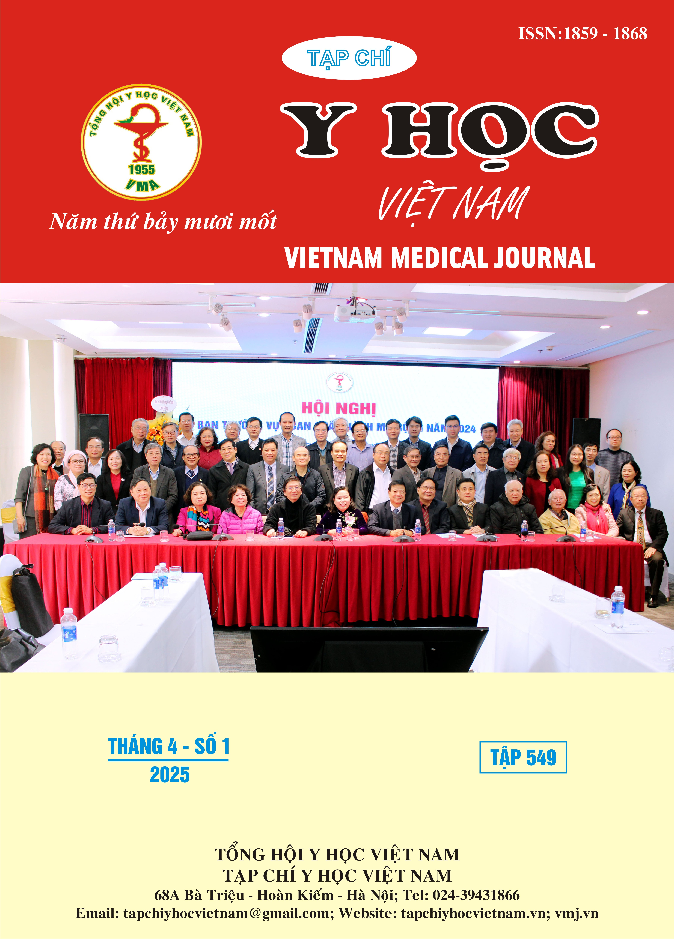NGHIÊN CỨU NỒNG ĐỘ NGAL HUYẾT THANH VÀ MỘT SỐ YẾU TỐ LIÊN QUAN Ở BỆNH NHÂN ĐỢT CẤP SUY TIM MẠN CÓ PHÂN SUẤT TỐNG MÁU GIẢM
Nội dung chính của bài viết
Tóm tắt
Mục tiêu nghiên cứu: Khảo sát nồng độ NGAL huyết thanh và một số yếu tố liên quan ở bệnh nhân đợt cấp suy tim mạn có phân suất tống máu giảm. Đối tượng và phương pháp nghiên cứu: Nghiên cứu mô tả cắt ngang, bệnh nhân đợt cấp suy tim mạn phân suất tống máu giảm đến khám và điều trị tại Bệnh viện Đa khoa Trung Ương Cần Thơ từ tháng 06 năm 2024 đến tháng 02 năm 2025. Kết quả: Tổng số 73 bệnh nhân, tuổi trung bình 67,88 ± 16,94, nam giới 60,3%. Khó thở chiếm tỷ lệ 71,2%. Trên Xquang phổi, có 38,4% sung huyết phổi và 23,3% tràn dịch màng phổi. Nồng độ NGAL trung bình là 65,37 ± 29,95 ng/mL. Bệnh nhân NYHA từ độ III trở lên có nồng độ NGAL cao hơn NYHA từ I-II, với 68,28 ± 30,69 ng/mL so với 47,04 ± 16,02 ng/mL. Nồng độ NGAL tương quan thuận với tuổi tác (r=0,246; p<0,05), huyết áp tâm thu (r=0,237; p<0,05) và tương quan nghịch với độ lọc cầu thận (r= -0,287, p<0,05). Kết luận: Bệnh nhân đợt cấp suy tim mạn có phân suất tống máu giảm, khó thở là triệu chứng thường gặp nhất. Nồng độ NGAL có mối tương quan thuận với tuổi tác, huyết áp tâm thu và tương quan nghịch với độ lọc cầu thận.
Chi tiết bài viết
Từ khóa
suy tim mạn phân suất tống máu giảm,, nồng độ NGAL huyết thanh
Tài liệu tham khảo
2. Gupta AK, et al. Evidence-based management of acute heart failure. Canadian Journal of Cardiology. 2021. 37(4), p. 621-631.
3. Nassar DK. Neutrophil gelatinase-associated lipocalin (NGAL) role in diagnosis of complications of liver cirrhosis. Egyptian Journal of Medical Microbiology. 2021. 30(2), p. 21-25.
4. Maisel AS, et al. Prognostic utility of plasma neutrophil gelatinase‐associated lipocalin in patients with acute heart failure: the NGAL EvaLuation Along with B‐type NaTriuretic Peptide in acutely decompensated heart failure (GALLANT) trial. European journal of heart failure. 2011. 13(8), p. 846-851.
5. Oikonomou E, et al. The association among biomarkers of renal and heart function in patients with heart failure: the role of NGAL. Biomarkers in medicine. 2018. 12(12), p. 1323-1330.
6. McDonagh TA, et al. 2021 ESC Guidelines for the diagnosis and treatment of acute and chronic heart failure: Developed by the Task Force for the diagnosis and treatment of acute and chronic heart failure of the European Society of Cardiology (ESC) With the special contribution of the Heart Failure Association (HFA) of the ESC. European heart journal. 2021. 42(36), p. 3599-3726.
7. Kajimoto K, et al. Etiology of heart failure and outcomes in patients hospitalized for acute decompensated heart failure with preserved or reduced ejection fraction. The American Journal of Cardiology. 2016. 118(12), p. 1881-1887.
8. Van Aelst LN, et al. Acutely decompensated heart failure with preserved and reduced ejection fraction present with comparable haemodynamic congestion. European Journal of Heart Failure. 2018. 20(4), p. 738-747.
9. Warraich HJ, et al. Physical function, frailty, cognition, depression, and quality of life in hospitalized adults≥ 60 years with acute decompensated heart failure with preserved versus reduced ejection fraction: insights from the REHAB-HF trial. Circulation: Heart Failure. 2018. 11(11), p. e005254.
10. De Berardinis B, et al. Comparison between admission natriuretic peptides, NGAL and sST2 testing for the prediction of worsening renal function in patients with acutely decompensated heart failure. Clinical Chemistry Laboratory Medicine. 2015. 53(4), p. 613-621.


